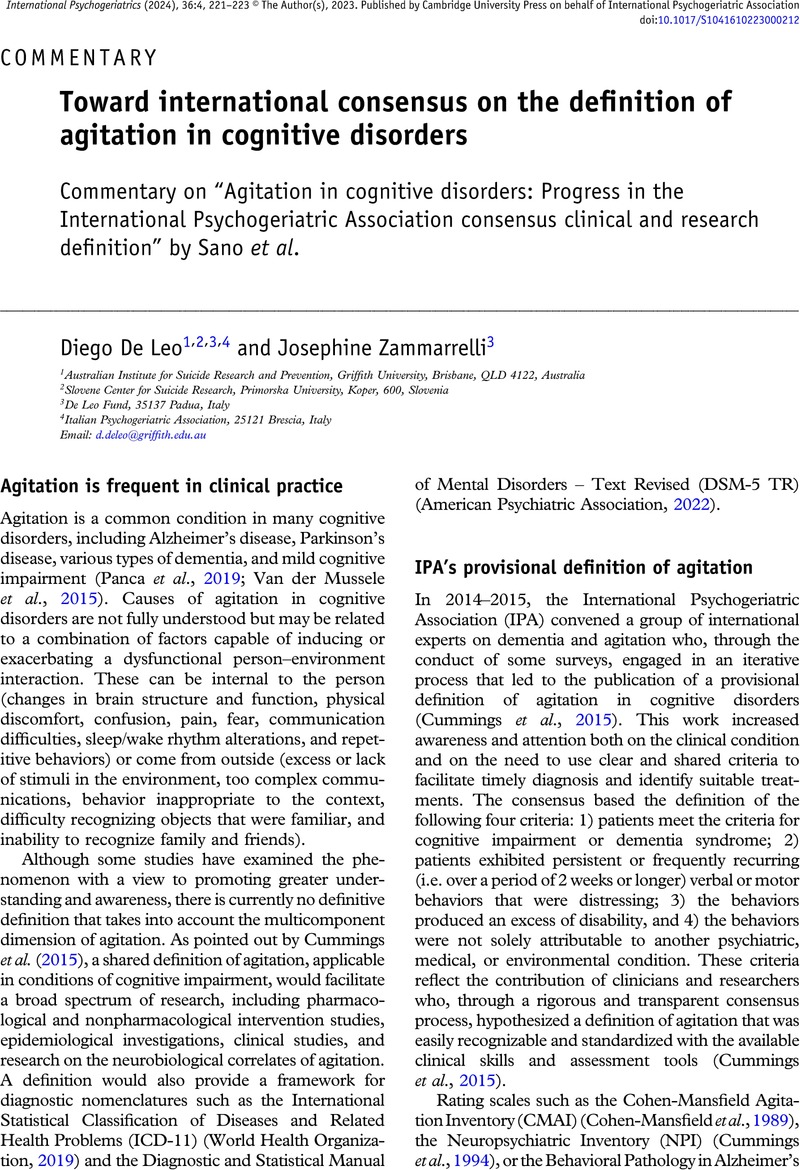No CrossRef data available.
Article contents
Toward international consensus on the definition of agitation in cognitive disorders
Commentary on “Agitation in cognitive disorders: Progress in the International Psychogeriatric Association consensus clinical and research definition” by Sano et al.
Published online by Cambridge University Press: 22 March 2023
Abstract
An abstract is not available for this content so a preview has been provided. Please use the Get access link above for information on how to access this content.

Information
- Type
- Commentary
- Information
- International Psychogeriatrics , Volume 36 , Special Issue 4: Issue Theme: Behavioral and Physical Impairments in Persons with Cognitive Disorders , April 2024 , pp. 221 - 223
- Copyright
- © The Author(s), 2023. Published by Cambridge University Press on behalf of International Psychogeriatric Association
References
American Psychiatric Association (2022). Diagnostic and statistical manual of mental disorders. 5th edition, (Text rev.). https://doi.org/10.1176/appi.books.9780890425787.Google Scholar
Cohen-Mansfield, J., Marx, M. S. and Rosenthal, A. S. (1989). A description of agitation in a nursing home. Journals of Gerontology, 44, M77–M84.CrossRefGoogle ScholarPubMed
Cummings, J. L., Mega, M., Gray, K., Rosenberg-Thompson, S., Carusi, D. A. and Gornbein, J. (1994). The Neuropsychiatric Inventory: comprehensive assessment of psychopathology in dementia. Neurology, 44, 2308–2314.10.1212/WNL.44.12.2308CrossRefGoogle ScholarPubMed
Cummings, J. et al. (2015). Agitation in cognitive disorders: International Psychogeriatric Association provisional consensus clinical and research definition. International Psychogeriatrics, 27, 7–17. https://doi.org/10.1017/S1041610214001963.CrossRefGoogle ScholarPubMed
De Deyn, P. P. and Wirshing, W. C. (2001). Scales to assess efficacy and safety of pharmacologic agents in the treatment of behavioral and psychological symptoms of dementia. Journal of Clinical Psychiatry, 62, 19–22.Google ScholarPubMed
Gilmore-Bykovskyi, A., Mullen, S., Block, L., Jacobs, A. and Werner, N. E. (2020). Nomenclature used by family caregivers to describe and characterize neuropsychiatric symptoms. Gerontologist, 60, 896–904. https://doi.org/10.1093/geront/gnz140.CrossRefGoogle ScholarPubMed
Knapp, M. et al. (2016). Predictors of care home and hospital admissions and their costs for older people with Alzheimer’s disease: findings from a large London case register. BMJ Open, 6, e013591. https://doi.org/10.1136/bmjopen-2016-013591.CrossRefGoogle ScholarPubMed
Panca, M. et al. (2019). Healthcare resource utilisation and costs of agitation in people with dementia living in care homes in England - The Managing Agitation and Raising QUality of LifE in Dementia (MARQUE) study. PLoS One, 14, e0211953. https://doi.org/10.1371/journal.pone.0211953.CrossRefGoogle ScholarPubMed
Polenick, C. A. et al. (2018). “The Filter is Kind of Broken”: family caregivers’ attributions about behavioral and psychological symptoms of dementia. American Journal of Geriatric Psychiatry, 26, 548–556.CrossRefGoogle ScholarPubMed
Reisberg, B., Borenstein, J., Salob, S. P., Ferris, S. H., Franssen, E. and Georgotas, A. (1987). Behavioral symptoms in Alzheimer’s disease: phenomenology and treatment. Journal of Clinical Psychiatry, 48, 9–15.Google ScholarPubMed
Sano, M., et al. (2023). Agitation in cognitive disorders: progress in the International Psychogeriatric Association consensus clinical and research definition. International Psychogeriatrics, 1–36. IPG-06-22-235.R1. https://doi.org/10.1017/S1041610222001041.CrossRefGoogle ScholarPubMed
Van der Mussele, S. et al. (2015). Agitation-associated behavioral symptoms in mild cognitive impairment and Alzheimer’s dementia. Aging & Mental Health, 19, 247–257. https://doi.org/10.1080/13607863.2014.924900.CrossRefGoogle ScholarPubMed
World Health Organization (2019). International statistical classification of diseases and related health problems, 11th edition, Geneva: WHO. https://icd.who.int/.Google Scholar

